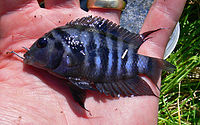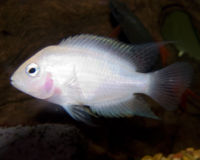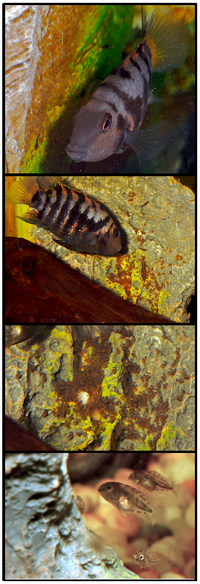- Convict cichlid
-
Convict cichlid 
Amatitlania nigrofasciata Scientific classification Kingdom: Animalia Phylum: Chordata Class: Actinopterygii Order: Perciformes Family: Cichlidae Subfamily: Cichlasomatinae Genus: Amatitlania
(Schmitter-Soto 2007)Species: A. nigrofasciata Binomial name Amatitlania nigrofasciata
(Günther, 1867)The Convict cichlid (Amatitlania nigrofasciata) is a fish species from the family Cichlidae, native to Central America,[1] also known as the zebra cichlid.[2] Convict cichlids are popular aquarium fish[1] and have also been the subject of numerous studies on fish behaviour.[3]
Contents
Taxonomy
Albert Günther originally described the species in 1867 after Frederick DuCane Godman and Osbert Salvin collected specimens in Central America.[4] In 2007, the species was moved from the genus Archocentrus to a new genus, Amatitlania based on Juan Schmitter-Soto's study of Archocentus species.[5] However, a 2008 study led by Oldrich Rican proposed moving the species in Cryptoheros and Amatitlania, including Amatitlania nigrofasciata into the genus Hypsophrys.[6]
The convict cichlid displays significant color variation across its range.[7][8] Some of these regional variants are now considered different species.[5] In the cichlid-keeping hobby, Rusty Wessel collected one such fish Amatitlania siquia "Honduran Red Point" from a stream in Honduras.[9][10] The Honduran Red Point Convict ranges from Atlantic Honduras south to Costa Rica.[5] Other new species formerly included in A. nigrofasciata are:
- Amatitlania coatepeque, from Lake Coatepeque in El Salvador, and
- Amatitlania kanna, from Panama's Atlantic coast
The type species, A. nigrofasciata, which used to cover all these species, is restricted to the northern population ranging from El Salvador to Guatemala on the Pacific coast and from Honduras to Guatemala on the Atlantic coast.[5]
A number of synonyms exist for this species including: Archocentrus nigrofasciatus, Cichlasoma nigrofasciatum, Cryptoheros nigrofasciatus and Heros nigrofasciatus.[11][12]
Etymology
The common name convict cichlid is, like the species name, derived from the vertical black stripes on the fishes body and their similarity to the striped prison uniforms of British convicts. Similarly, the species epithet nigrofasciatus literally means black-striped.[13]
Description
The wild-type of the species has 8–9 black vertical bars on a blue-grey body, along with a dark blotch on the operculum.[1] Juvenile convict cichlids are monomorphic until they reach sexual maturity. Unusually for fish, the female is more highly coloured.[14] The male is mostly gray with light black stripes along the body. Males are larger than females, and they have more pointed ventral, dorsal and anal fins which often extend into filaments. In addition, older males frequently develop vestigial fatty lumps on their foreheads. She has more intense black bands across the body, and pink to orange colouration in the ventral region and on the dorsal fin.[15][16] The average standard length of mature males in the wild ranged from 6.3–6.6 centimeters, while breeding–sized females ranged from 4.2–5.5 centimeters.[14] The maximum standard length has been reported to be 10 centimeters, with total length near 12 centimeters (4.7 in).[1][17] Body weight has been reported to range from 34–36 grams (1.2–1.3 oz).[1] Selective breeding has resulted in a leucistic strain of convict cichlids, in which the dark barring of the wild type is absent.[15] These are also known as white convicts, pink convicts, gold convicts and A. nigrofasciata "Kongo",.[1][16] The leucistic colouration is caused by a mutation in an autosomal gene and is recessively inherited.[18]
Range and habitat
 A female convict cichlid caught on a hook and line, in the heated outflow of a coal powerplant in Victoria, Australia.
A female convict cichlid caught on a hook and line, in the heated outflow of a coal powerplant in Victoria, Australia.
Convict cichlids are endemic to the lakes and streams of Central America. In particular, the species occurs along the eastern coast of Central America from Guatemala to Costa Rica, and on the western coast from Honduras to Panama.[1] Convict cichlids prefer moving water, and are most frequently found in habitats with cover in the form of rocks or sunken branches.[19] Convict cichlids are relatively tolerant of cool water, an ability which has allowed the species to colonise volcanic lakes at elevations of 1,500 meters (4,900 ft).[20] At four natural habitats of the convict cichlid in Costa Rica, the pH was found to range from 6.6–7.8, while alkalinity ranged from 63 to 77 ppm CaCO3. The daily water temperature ranged from 26–29 °C (79–84 °F).[14]
Feral populations
The species also occurs outside its natural range in Australia: in the warm effluent of power stations in Victoria, and in tropical Queensland.[21] In addition to Australia, the species has been introduced to Réunion, Japan,[1] Mexico,[12] and the USA.[22][23]
Feeding
In natural habitats, the species feeds on crustaceans, small fish, insects, various worms, plants and algae. Social status and associated stress can affect digestive function in convict cichlids.[24]
Reproduction
The species can reach sexual maturity at as young as 16 weeks, though sexual maturity more commonly occurs at 6 months.[20] Sexually mature convicts form monogamous pairs and spawn in caves or crevices. In the wild, the fish excavate caves by moving earth from underneath large stones.[14] Females lay the eggs on the upper or side surfaces of the cave to which they adhere.
Breeding
Like most cichlids, convicts brood (exhibit parental care of) both eggs and free-swimming fry.[25]
After fertilization the eggs hatch after approximately 72 hours. During that time, the parents expel intruders and potential egg predators from around the nest. They also fan the eggs, moving water with their fins over the clutch to bring oxygen to the eggs. They fan the eggs both day and night, using their sense of smell to recognize the presence of the eggs in the dark, and keeping their pelvic fins in contact with the eggs to remain at the right distance for fanning.[26][27] The parents also recognize each other via their sense of smell, and sniff out and react to the presence of potential predators.[28]
After hatching, a further 72 hours is required for the larvae to absorb their yolk sacs and develop their fins prior to becoming free-swimming fry.[29] While in this free swimming stage, fry forage during daylight in a dense school and return to the cave or crevice for the night.[30] Like other cichlids, the parents also retrieve their young just before dark, sucking up three or four fry at a time into their mouth, swimming back to the nest, and spitting the young into it. The parents do this in anticipation of night arrival, using an internal time sense to know that night is approaching, as shown by laboratory experiments in which convict cichlids continued to retrieve even before nights that were not preceded by any signal such as dim light.[31] During the night, the fry bunch up at the bottom of the cave or nest, where the parents fan them.[32]
Both parents remain involved in guarding the fry from brood predators and engage in behaviors to assist feeding such as moving leaves or fin digging.[14] Brood care of eggs, larvae and free-swimming juveniles in the wild can last 4–6 weeks,[14] and occurs only once per season for the majority of females.[14] In contrast, females in aquariums are known to breed many times per year with short intervals of 12–13 days between broods, as long as suitable rocks or similar surfaces are available for them to lay their eggs on.[33] In captivity, breeding pairs of convict cichlids have been demonstrated to adopt similarly aged fry from other parents.[34] In other cichlids it has been suggested this behavior may reduce predation on the fry belonging to the adoptive parents, through a dilution effect.[35]
Aquarium care
Convict cichlids are easily maintained and bred in aquaria.[15][16] Decorate the aquarium to mimic the natural environment and include rocks and artificial caves for breeding.[15] The species is an unfussy omnivore and most types of prepared fish foods are readily accepted.[36] The species also consumes aquatic plants.[15][16] Convict cichlids are aggressively territorial during breeding and pairs are best kept alone. Brood care is reduced in aquarium strains.[15][16] Due to the species' tendency to dig, external filtration is superior to undergravel filter systems.[20] Its relatively small size, along with ease of keeping and breeding, make the convict an ideal cichlid for beginners and advanced aquarists alike interested in observing pair bonds and brood care.[20]
See also
References
- ^ a b c d e f g h Froese, Rainer, and Daniel Pauly, eds. (2006). "Archocentrus nigrofasciatus" in FishBase. April 2006 version.
- ^ ITIS Report. "Archocentrus nigrofasciatus". Integrated Taxonomic Information System. http://www.itis.gov/servlet/SingleRpt/SingleRpt?search_topic=TSN&search_value=648207. Retrieved 2007-03-30.
- ^ Robins CR, Bailey RM, Bond CE, Brooker JR, Lachner EA, Lea RN, Scott WB (1991) World fishes important to North Americans. Exclusive of species from the continental waters of the United States and Canada. Am. Fish. Soc. Spec. Publ. 21: p. 243.
- ^ Günther A (1866) On the fishes of the states of Central America, founded upon specimens collected in fresh and marine waters of various parts of that country by Messrs. Salvin and Godman and Capt. J. M. Dow. Proc. Zool. Soc. Lond. 600–604.
- ^ a b c d "Convict and Jack Dempsey placed in new genera". Archived from the original on December 28, 2007. http://web.archive.org/web/20071228234519/http://www.practicalfishkeeping.co.uk/pfk/pages/item.php?news=1399. Retrieved 2008-06-27.
- ^ Heijns, W. (July 2009). "Central American heroine cichlids, a phylogenetic approach". Cichlid News. pp. 14–22.
- ^ Heijns W (2001) A convict from the Volcano Cichlid Room Companion Ed. Juan Miguel Artigas Azas.
- ^ Azas JMA (2002) Cryptoheros, The Small Central American Cichlids Cichlid Room Companion Ed. Juan Miguel Artigas Azas.
- ^ Wessel R (2006) The Honduran Red Point: A beautiful blue convict-type species from Honduras Tropical Fish Hobbyist 54: 104–106.
- ^ Borstein R (2005) Archocentrus sp. "Honduran Red Point" Greater Chicago Cichlid Association
- ^ Froese, R. and D. Pauly. Editors.. "Archocentrus nigrofasciatus, synonyms". FishBase. http://filaman.uni-kiel.de/Nomenclature/SynonymsList.cfm?ID=3615&GenusName=Archocentrus&SpeciesName=nigrofasciatus. Retrieved 2007-03-30.
- ^ a b Juan Miguel Artigas Azas. "Cryptoheros nigrofasciatus (Günther, 1867)". The Cichlid Room Companion. http://cichlidae.com/gallery/species.php?s=200. Retrieved 2007-03-30.
- ^ Innes, William (1966). Exotic Aquarium Fishes. p. 395.
- ^ a b c d e f g Wisenden BD (1995) Reproductive behavior of free-ranging convict cichlids, Cichlasoma nigrofasciatum Environmental Biology of Fishes 43: 121–134.
- ^ a b c d e f Riehl, Rüdiger. Editor.; Baensch, HA (1996. 5th Edn.). Aquarium Atlas. Germany: Tetra Press. ISBN 3-88244-050-3.
- ^ a b c d e Sands D (1994) A fishkeepers guide to Central American cichlids. Tetra Press. Belgium pg 59–60.
- ^ Kullander, S.O., 2003. Cichlidae (Cichlids). p. 605-654. In: R.E. Reis, S.O. Kullander and C.J. Ferraris, Jr. (eds.) Checklist of the Freshwater Fishes of South and Central America. Porto Alegre: EDIPUCRS, Brasil.
- ^ Itzkovich J, Rothbard S, Hulata G (1981) Inheritance of pink body colouration in cichlasoma nigrofasciatum Günther (Pisces, Cichlidae). Genetica 55: 15–16.
- ^ Conkel, D (1993) Cichlids of North and Central America T.F.H. Publications, Inc., USA.
- ^ a b c d Loiselle, Paul V. (1995). The Cichlid Aquarium. Germany: Tetra Press. ISBN 1-56465-146-0.
- ^ Koehn JD, MacKenzie RF (2004) Priority management actions for alien freshwater fish species in Australia. New Zealand Journal of Marine and Freshwater Research 38: 457–472.
- ^ Yamamoto MN, Tagawa AW (2000) Hawai'i's native and exotic freshwater animals. Mutual Publishing, Honolulu, Hawaii. p. 200
- ^ Page LM, Burr BM (1991) A field guide to freshwater fishes of North America north of Mexico. Houghton Mifflin Company, Boston. p. 432
- ^ Earley RL, Blumer LS, Grober MS (2004) The gall of subordination: changes in gall bladder function associated with social stress Proceedings of the Royal Society B: Biological Sciences 271: 7–13.
- ^ Keenleyside MHA (1991) Parental Care. In: Cichlid Fishes: behavior, ecology and evolution Chapman and Hall, London. p. 191-208.
- ^ Reebs, S.G., and Colgan, P.W., 1991, Nocturnal care of eggs and circadian rhythms of fanning activity in two normally diurnal cichlid fishes, Cichlasoma nigrofasciatum and Herotilapia multispinosa, Animal Behavior 41: 303–311
- ^ Reebs, S.G., and Colgan, P.W., 1992, Proximal cues for nocturnal egg care in convict cichlids, Cichlasoma nigrofasciatum, Animal Behavior 43: 209–214.
- ^ Reebs, S.G., 1994, Nocturnal mate recognition and nest guarding by female convict cichlids (Pisces, Cichlidae: Cichlasoma nigrofasciatum), Ethology 96: 303–312
- ^ Noakes DLG (1991) Ontogeny of behavior in cichlids. In: Cichlid Fishes: behavior, ecology and evolution Chapman and Hall, London. p. 209-224.
- ^ Wisenden BD (1994) Factors affecting male mate desertion in the bi parental cichlid fish (Cichlasoma nigrofasciatum) in Costa Rica. Behavioral Ecology 5: 439–447.
- ^ Reebs, S.G., 1994, The anticipation of night by fry-retrieving convict cichlids, Animal Behavior 48: 89–95.
- ^ Lavery, R.J., and Reebs, S.G., 1994, Effect of mate removal on current and subsequent parental care in the convict cichlid (Pisces: Cichlidae), Ethology 97: 265–277.
- ^ Wisenden DB (1993) Female convict cichlids adjust gonadal investment in current reproduction in response to relative risk of brood predation. Canadian Journal of Zoology 71: 252–256.
- ^ Espmark Y, Knudsen T (2001) Intraspecific brood adoption in the convict cichlid with respect to fry of two color morphs Journal of Fish Biology 59: 504–514.
- ^ Nelson CTJ, Elwood RW (1997) Parental state and offspring recognition in the bi parental cichlid fish Pelvicachromis pulcher. Animal Behavior 54: 803–809.
- ^ Mills D, Vevers G (1989) The Tetra encyclopedia of freshwater tropical aquarium fishes. Tetra Press, New Jersey.
Responsibility: Keepers/breeders of the Convist Cichlid must accept responsibility for the proper disposal of their pro-generation. These cichlids are prodigous breeders and require responsible behavior by their caregivers. Releasing breeding adults and subadults/fry into the wild environment is not the responsible response to deal with over-population of aquariums. The responsible response is to 1) deliver unwanted fish to your local aquarium store for resale/disposal or 2) disposal of unwanted cichlids in a responsible way. The most responsible method of disposing of un-wanted fish is to place them in an appropriate size container and freeze them in your refigerators freezer compartment. Results of the procedure will be a fish, vertical in position, frozen in ice, with no indication of trauma (the lowering temperature places the cold-blooded fish in a state of torpor and painless death). Alternatives have been suggested that unwanted fish should be placed in boiling water, which in my opinion, suggests a death (with an instant feeling of pain) less humane. By all means do not introduce this (or any aquarium species, including snails) species into the wild native habitats of the United States. The impact of non-native introduction to native habitats are catastrosphic reqiuring expensive research (to document impact on native fishes), and vast amounts of money to eradicate the "pest" species, often with no impact on the invasive and extinction (or imperil) of the native. While habitats of the eastern U.S. may be forgiving to exotic introductions, habitats in the West are unable to tolerate non-native introductions without intervention. All western habitats contain native fish species that are listed as "endangered", "threatened" or "extinct" (very few species survive "extinction") These habitats have evolved over eons of time, with desert species of fish who have successfully negotiated isolation and interaction with compatriaiate plants and animals, and are ill-equipped to deal with non-natives who possess skills and adaptations to dominate passive habitats. In short, non-natives over-react to confrontations which natives have little or no skills to defend. I am relunctant to give specific habitats of concern because I do not want to participate in supplying information to irresponsible aquarists who, for whatever reason, might like to do a negative introduction.
Categories:- Fish of Central America
- Cichlasomatinae
- Fish of Guatemala
- Animals described in 1867
Wikimedia Foundation. 2010.




